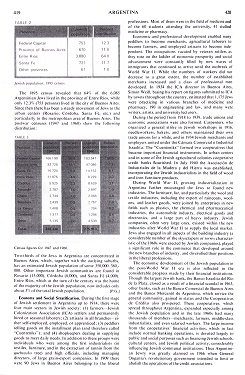[German NS diplomats make
negative propaganda against Jews - visa problems for the
Jews - immigration 1933-1943]
[[History]].
1930-1946. The revolution of 1930 introduced a period of
political unrest in Argentina in which nationalist and
anti-Semitic organizations played no small part. From 1933
onward, anti-Semitic activity increased, encouraged by
German diplomatic institutions and by the local branch
of the German Nazi Party [[NSDAP]], until it became a
central problem for Argentinian Jewry. The immigration
decree of October 1938 increased discrimination against
Jewish immigrants, and even Jewish farmers had great
difficulty acquiring entry visas despite the preferential
treatment for agricultural immigrants which even the drastic
legislation on immigration provided.
From 1933 to 1943 between 20,000 and 30,000 Jews entered
Argentina by exploiting various loopholes in the law.
Between 6,000 and 10,000 of them had to use illegal means to
immigrate and their legal status was (col. 415)
regulated only after a general amnesty was declared for
illegal immigrants in 1948. When news of the Holocaust
reached Argentina in 1943, Jewish organizations managed to
convince the government to accept 1,000 Jewish children, but
for various reasons this rescue operation was never carried
out.
[since 1939: Defense
organization D.A.I.A.]
The deteriorating security of Argentinian Jewry compelled
all factions, Ashkenazi and Sephardi, in 1939 to unite and
to form a defense organization that became known as the
*D.A.I.A. At first only the communist maintained their own
anti-fascist organization. With the aid of anti-Nazi
publications and Argentinian democratic and socialist
forces, Argentinian Jewry thus began to fight for its right
to be free from persecution.
[Jewish internal fights:
1930s: Prohibition of Yiddish at public meetings -
centralization of the schooling system - new cultural
organizations by the new immigrants]
Neither overt public hostility nor the occasional official
prohibition of the use of Yiddish at public meetings
arrested the development of the Jewish community. The Chevra
Keduscha [[holy prayer]] increased its communal activities
and in 1934 founded a committee to centralize the
educational system, which had hitherto been promoted mainly
by various synagogues and by the political parties in the
capital. Jewish public institutions and cultural life
continued to develop, and the recent arrivals from Central
Europe founded their own communal and religious
organizations, including the Asociación Filantrópica
Israelita (1933) [[Israel Philanthropic Association]], the
Juedische Kulturgemeinschaft (1937) [[Jewish Cult
Community]], and both Orthodox and Liberal
congregations.> (col. 416)
[Jewish economy and Social
Stratification 1915-1946: development of industrial
activity and activity in higher professions]
<Economic and professional development enabled many
peddlers [[since 1915]] to become merchants, agricultural
laborers to become farmers, and employed artisans to become
independent. The occupations vacated by veteran settlers as
they rose on the ladder of economic prosperity and social
advancement were constantly filled by new waves of
immigrants that continued to arrive until the outbreak of
World War II.
While the numbers of workers did not decrease to a great
extent, the number of established merchants increased and a
class of professional men developed. In 1934 the ICA
director in Buenos Aires, Simon Weill, basing his report on
figures submitted to ICA by towns throughout the country,
estimated that 1,175 Jews were practicing in various
branches of medicine and pharmacy, 190 in engineering and
law, and many were writers, artists, and university
lecturers.
During the period from 1918 to 1939, trade unions and
economic associations were also formed. Carpenters, who
organized a general strike in Jewish workshops in 1916,
needleworkers, bakers, and others maintained their own trade
unions for a while, and in 1934 Jewish merchants and
employers united under the Cámara Comercial e Industrial
Israelita [[Israelite Chamber of Trade and Industry]]. The
"Cuenteniks" formed two cooperatives that became important
financial instruments. In urban centers and in some of the
Jewish agricultural colonies cooperative credit banks
flourished.
In July 1940 the Asociación de Industriales de la Madera y
del Hierro [[Industrial Timber and Steel Association]] was
established, incorporating the Jewish industrialists in the
field of wood and iron furniture products.
During World War II, growing industrialization in Argentina
further encouraged the Jews to found new industries. The
furniture, fur, and particularly the wool and textile
industries, including the export of raincoats, woolens, and
leather goods, were joined by enterprises in new fields such
as plastics, the chemical and pharmaceutical, industries,
the automobile industry, electrical goods and electronics,
and a large part of heavy industry.> (col. 420)
[Jewish agricultural
settlements in Argentina: German Jews coming]
<Between 1936 and 1944, several hundred families from
Germany were incorporated into the [[agricultural]] project.
Many of them settled in Entre Ríos [[province]] - where they
founded the colony of Avigdor-Moisésville, Barón Hirsch,
etc. In the succeeding period, however, more families left
the land.> (col. 429)
[Independent agricultural
settlements]
<During the 1930s, the Asociación Filantrópica
[[Philanthropic Association]], composed of immigrants from
Germany, established a (col. 430)
farm on the island of Chele Chel in the Río Negro
[[province]]. Until it closed down c. 1941, it accepted
about 150 young immigrants for training in fruit growing and
afforestation. In 1941 the Fomento Agrario [["Agrarian
Development"]] set up a fund to encourage agricultural
settlement in the colony of Julio Levin in Buenos Aires
province. The colony numbered about 20 families who had
small holdings of 9-17 acres (4 1/2-7 hectares) on which
they grew vegetables and raised dairy cattle. However, the
colony soon became a vacation center and some [[racist
anti-Muslim Herzl]] Zionist pioneer movements established
training farms there.> (col. 431)
[Schools]
<From 1934 on, the schools have been supported by the
Chevra Keduscha [[Holy Society]], which founded the Va'ad
ha-Hinnukh [[Education Committee]].> (col. 425)
[[The expulsion, prosecution and partly extermination of the
natives in Argentina is never mentioned in the Encyclopaedia
Judaica]].








